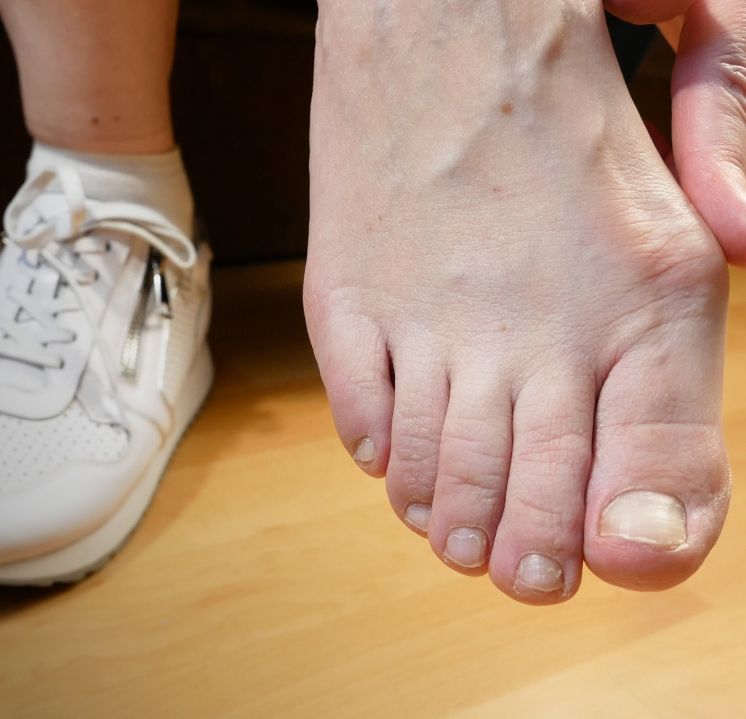Hammer Toes & Claw Toes
Hammer toes and claw toes are both toe deformities that involve the abnormal bending of the toes, but they differ in the joints affected and the positioning of the toes.

Hammer Toes:
- What They Are: Hammer toes are characterised by an abnormal bend in the middle joint of a toe, causing the toe to bend downward like a hammer. This deformity typically affects the second, third, or fourth toes.
- Appearance: The affected toe may appear like an upside-down "V" shape, with the middle joint bent downward while the end of the toe points upward.
Claw Toes:
- What They Are: Claw toes involve an abnormal bend in multiple joints of the toe, causing the toe to bend upward at the joint closest to the foot (proximal interphalangeal joint) and downward at the middle joint (middle phalangeal joint).
- Appearance: The affected toes may appear curved or claw-like, with the joints bent in opposing directions, resembling a bird's claw.
- Hammer toes: Hammer toes are often caused by factors such as foot structure abnormalities (high arches or flat feet), tight or narrow footwear, genetics, age-related changes in foot mechanics, and sometimes trauma or injury to the toe.
- Claw toes: Claw toes may be caused by nerve damage from conditions like diabetes, alcoholism, or other neurological disorders. Other causes include arthritis affecting the toe joints, footwear that is too tight or narrow, genetics, and trauma to the toes.
Call us at 62355225 today.
Hammer toes and claw toes are typically diagnosed through a combination of clinical assessment, physical examination, and sometimes imaging tests.
- Medical History Review: The orthopaedic specialist may about any symptoms you’ve experienced relating to your toes, any past injuries or underlying health conditions like diabetes or arthritis that could contribute to toe deformities.
- Physical Examination: The doctor will visually inspect your toes and feet to look for signs of deformity or abnormalities such as a bent appearance or corns/calluses, and assess your foot mechanics.
- Range of Motion Assessment: The orthopaedic specialist may gently move your toes to evaluate their range of motion and flexibility.
- Imaging Tests: In some cases, X-rays may be performed to get a detailed view of the toe joints and assess the severity of the deformity.
- Neurological Evaluation (for Claw Toes): If claw toes are suspected to be caused by nerve damage (neuropathy), the orthopaedic doctor may perform neurological tests to assess sensation and reflexes in the feet and lower legs.
The treatment of hammer toes and claw toes may be conservative (non-surgical) in nature or surgical, depending on the severity of the condition. This includes:
Non-surgical Treatments
- Orthotic Devices: Custom-made orthotic inserts or shoe pads may be prescribed to help redistribute pressure on the toes and correct foot mechanics.
- Toe Exercises: Specific exercises and stretches for the toes and feet may be recommended to improve flexibility, strengthen muscles, and correct imbalances that contribute to hammer toes and claw toes.
- Padding and Taping: Applying padding or tape to the toes can help cushion the affected area, reduce friction, and relieve pain caused by corns or calluses that develop due to the abnormal toe positioning.
- Medications: Nonsteroidal anti-inflammatory drugs (NSAIDs) or pain relievers may be prescribed to alleviate pain and inflammation associated with hammer toes and claw toes.
Surgical Treatments
- Arthroplasty (Joint Resection): A portion of the bent joint's bone is removed to straighten the toe. It is typically used for less severe, flexible hammer toes and claw toes.
- Arthrodesis (Joint Fusion): The toe joint is fused, keeping the toe straight permanently. This is commonly used for more severe, rigid deformities.
- Tendon Transfer: Tendons causing the toe to bend are repositioned to restore normal function. This addresses muscle imbalances in both hammer toes and claw toes.
- Soft Tissue Release: Tight tendons and joint capsules are cut or released to allow the toe to straighten. This option is used for flexible deformities.
- Weil Osteotomy: A portion of the metatarsal bone is cut and repositioned to relieve pressure and shorten the toe. It's often used for claw toes, especially with metatarsalgia.
Schedule a consultation at 62355225 today.
When should I see a doctor for hammer toes or claw toes?
+
Can hammer toes and claw toes lead to complications?
+

